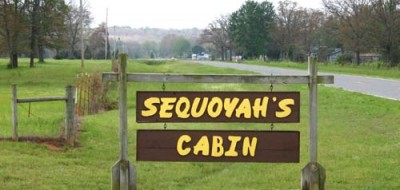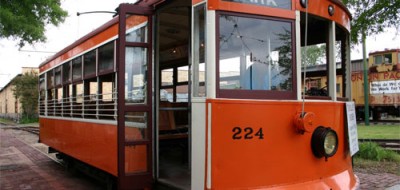Before the advent of buses and subway systems, streetcars were the earliest means of mass transportation in most American cities. From the late 1800s through the 1930s, trolleys, as they were affectionately called, carried shoppers and commuters downtown and back home again along steel rails embedded in the roadways, powered by overhead lines. Even today, some cities still retain their trolley systems, and others have brought them back as a tourist draw or alternative means of transportation.
In Fort Smith, Arkansas, the Fort Smith Railway Company began offering the area’s first public transportation in 1883, with three mule-drawn rail cars. As the cars rattled along the unpaved streets, the drivers calling “Gee” and “Haw” echoed through the small downtown area.
The first electric streetcar service began a decade later when the Fort Smith & Van Buren Electric Street Railway Light & Power Company was formed and began operating two electric trolleys. By 1899, all of the streetcar lines in Fort Smith were electrified and running with open-platform cars. The riders were protected by a roof, but the motorman stood outside in the elements, and did the braking by hand, which made their use dependent on good weather.
In 1903, the Fort Smith Railway Company and the Fort Smith & Van Buren Electric Street Railway Light & Power Company combined to form the Fort Smith Traction Light & Power Company. A few months later the company reorganized and became the Fort Smith Light & Traction Company (FSL&T).
By 1911, enclosed streetcars had replaced the open-platform units. These new cars were not bothered by weather and could run year-round. Airbrakes were standard, making them safer. But everything has a trade-off, and while the new cars were more comfortable, their heavier weight required more track maintenance.
The enclosed Birney “Safety Car” appeared in Fort Smith in 1920. It was a lighter car and had a “dead man control” designed to stop the car and open the door if the motorman did not exert downward pressure on the control handle or depress a floor mounted pedal with his foot. These new cars were heated by under-seat electric heaters, providing passenger comfort in cold weather.
The economic difficulties caused by the Great Depression, the growing use of automobiles, and legal challenges over the company’s fares, routes, and bridge tolls caused serious financial problems for the Fort Smith Light & Traction Company, and in 1933 it became a subsidiary of the Oklahoma Gas & Electric Company. The streetcars made their final run on November 15, 1933 and the company went out of business. All 33 miles of Fort Smith’s trolley tracks were ripped up and sold for salvage. The streetcars were scrapped, bought by people who turned them into cabins, sheds, and diners.
In the early 1980s, the Fort Smith Streetcar Restoration Association was formed and began acquiring vintage streetcars to preserve this important era in the city’s history. In 1985, the Association erected a car barn at 100 South Fourth Street, the former site of the Midland Valley Railroad yard. This became the Fort Smith Trolley Museum. The building’s three sets of towering front doors were taken from the old Frisco roundhouse before it was torn down.
FSL&T car #224, the first streetcar to be restored by the new Fort Smith Trolley Museum, spent many years as a diner in Ashdown, Arkansas. Two other Fort Smith Light & Traction car bodies, #205 and #221, were located in Mulberry, Arkansas and #205 was donated to the museum. On June 21, 1979, after 46 years, car #205 was back home in Fort Smith, proudly displaying its “Car Barn” destination sign, on its way to restoration. Aged and faded by time, and riding on a flatbed truck, it was part of a dream for members of the museum and the people of Fort Smith. The trolleys were coming back!
After five years of restoration, Car #205 was ready to roll. With no track to run on, it was mounted on rubber-tired wheels. For years it was displayed in parades and used to sell ice cream at the city’s annual Riverfest, raising both funds and awareness of the Fort Smith Trolley Museum.
After completion of the overhead wire system needed to carry the 600 volt DC current, car #224 began operating on May 19, 1991. The route ran 1,200 feet, from the Fort Smith Trolley Museum to the Old Fort Museum (now called the Fort Smith Museum of History) and back again on an abandoned Frisco Freight Systems spur track.
Today the Fort Smith Trolley Museum features Car #224, a working, fully-restored 1926 electric streetcar that makes regular half-mile runs between the Fort Smith National Cemetery, down Garrison Avenue to the front of Ross Pendergraft Park, and on to a west-end stop on Main Street near the Fort Smith Museum of History. The museum’s Car Barn has a collection of old railroad passenger cars, engines, old Fort Smith buses, and other transportation artifacts.
The car barn is equipped with a mechanic’s pit and the tools necessary for restoration work. Since it is a “working museum,” visitors have the opportunity to see restoration work in progress. Large display cases along one wall hold railroad and streetcar memorabilia.
The Fort Smith Trolley Museum now has four of the original 58 Fort Smith streetcars. A 1904 Hot Springs Street Railway doubletruck car, which is similar to cars that operated in Fort Smith, is currently being restored, along with several other vintage streetcars.
In addition to the trolleys, the Museum is home to a rail collection that includes a Frisco steam engine and tender which had been on display at Kay Rodgers Park since 1954. Other rolling stock includes three cabooses, a former military power car and dining car, and three boxcars donated to the museum by the Union Pacific Railroad and Burlington Northern Railroad. The museum also has three internal combustion locomotives and a trackmobile.
Rubber-tired vehicles include a 1939 Little Rock bus and three former Fort Smith buses, one of which was used in the filming of the movies Biloxi Blues and Tuskegee Airmen at nearby Fort Chaffee. A 1932 American LeFrance Fort Smith fire truck and a Ford Model T truck that was used to deliver groceries in Fort Smith round out the collection.
Local artist John Bell designed a mural for the Fort Smith Trolley Museum in 1990, which depicts the era of trolleys in Fort Smith. It includes a mule-drawn car, an open car, a semi-convertible closed car, and a Birney safety car.
No visit to historic Fort Smith would be complete without a ride on the restored trolley. As the car rattles and bumps down the steel rail lines, the driver shares the history of the city, the streetcar lines, and explains the operation of the antique streetcar. It not only is a step back in time, but a ride back in time as well.
The Fort Smith Trolley Museum is located at 100 South Fourth Street, a couple of blocks from Fort Smith National Historic Site. For more information, call (479) 783-0205 or (479) 783-1237.


Rex Kuykendall
would you be interested in a volunteer to work on the trolly? I spent my career in transportation. I also have a friend that would like to help too. I am pretty good at restoration.